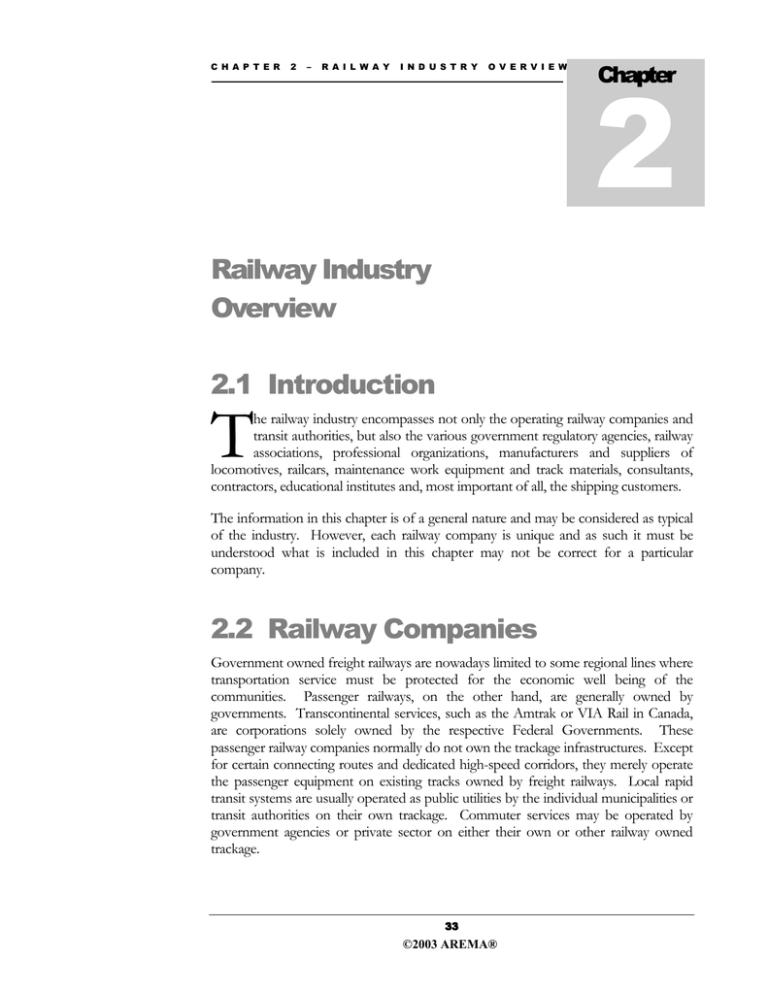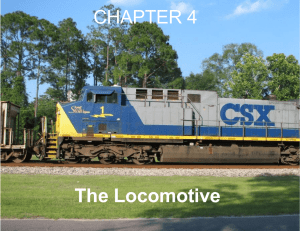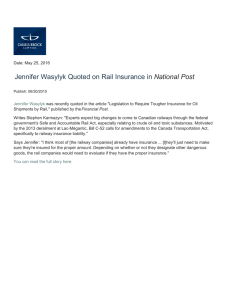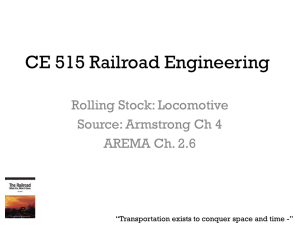Railway Industry Overview
advertisement

C H A P T E R 2 – R A I L W A Y I N D U S T R Y O V E R V I E W Chapter Railway Industry Overview 2.1 Introduction T he railway industry encompasses not only the operating railway companies and transit authorities, but also the various government regulatory agencies, railway associations, professional organizations, manufacturers and suppliers of locomotives, railcars, maintenance work equipment and track materials, consultants, contractors, educational institutes and, most important of all, the shipping customers. The information in this chapter is of a general nature and may be considered as typical of the industry. However, each railway company is unique and as such it must be understood what is included in this chapter may not be correct for a particular company. 2.2 Railway Companies Government owned freight railways are nowadays limited to some regional lines where transportation service must be protected for the economic well being of the communities. Passenger railways, on the other hand, are generally owned by governments. Transcontinental services, such as the Amtrak or VIA Rail in Canada, are corporations solely owned by the respective Federal Governments. These passenger railway companies normally do not own the trackage infrastructures. Except for certain connecting routes and dedicated high-speed corridors, they merely operate the passenger equipment on existing tracks owned by freight railways. Local rapid transit systems are usually operated as public utilities by the individual municipalities or transit authorities on their own trackage. Commuter services may be operated by government agencies or private sector on either their own or other railway owned trackage. 33 ©2003 AREMA® C H A P T E R 2 – R A I L W A Y I N D U S T R Y O V E R V I E W The tractive effort (in pounds) available from a locomotive can be roughly calculated as: Tractive Effort (lbs.) = Horsepower X (308) Speed (mph) Where 308 is 82% of 375 lb-miles per hour per hp. For example, a 3000 hp locomotive will have approximately 74,000 lbs. tractive effort at 12.5 mph. 2.6.2 Tractive Force and Adhesion It is the tractive force at the locomotive driving wheels (drivers) at the rail that starts and moves tonnage up various grades. The maximum tractive force that can be developed at the rail is equal to the weight on drivers multiplied by the adhesion (coefficient of friction) of the wheels on the rail. The primary factors, among others, affecting adhesion are rail condition and speed. Adhesion decreases as speed increases. At about 10 mph, adhesion varies from less than 10% on slimy, wet rail to about 40% on dry, sanded rail. In general, with the aid of the sanders, approximately 25% adhesion is usually available. As all the wheels on most diesel locomotives are driving wheels, the weight of the locomotives must be about four times the tractive force developed. The HHP (high horsepower) units for main line service weigh about 195 tons each on 6 axles. The maximum tractive force is therefore approximately 97,000 lb. per locomotive or 16,000 lb. per axle; that is, if there is enough horsepower at the wheel rims to develop the tractive effort. 2.6.3 Drawbar Pull After some of the tractive effort is used to move the locomotive itself, the remaining effort, in the form of “drawbar pull,” is used to move the rest of the train. As the train speed increases, the tractive effort from the locomotives decreases and the drawbar pull available to move the train also decreases. Due to the limited strength of drawbars and coupler knuckles, the number of locomotives or motorized axles that can be used in the head end of a train is restricted. Although rated with a minimum strength of 350,000 lb. (general service coupler made of Grade B steel), coupler knuckle failure may happen at 250,000 lb. due to age and wear. Grade E knuckles used on some captive services may have an ultimate strength of 650,000 lb. To avoid the risk of drawbar failure enroute, it is recommended to limit the number of motorized axles in a locomotive consist to 18 (three 6-axle units). If more tractive 55 ©2003 AREMA® C H A P T E R 2 – R A I L W A Y I N D U S T R Y O V E R V I E W effort is required to move the tonnage of a train, the option of in-train motive power should be considered. 2.6.4 Train Resistance Train resistance, the force required to move a train, is the sum of the rolling resistance on tangent level track, grade resistance and curve resistance of the locomotives and cars. Other resistances due to wind velocity, tunnels or different train marshalling will not be discussed here. Rolling Resistance Rolling Resistance is the sum of the forces that must be overcome by the tractive effort of the locomotive to move a railway vehicle on level tangent track in still air at a constant speed. These resistive forces include: § Rolling friction between wheels and rail that depends mainly on the quality of track. § Bearing resistance, which varies with the weight on each axle and, at low speed, the type, design and lubrication of the bearing. § Train dynamic forces that include the effects of friction and impact between the wheel flanges against the gauge side of the rail and those due to sway, concussion, buff and slack-action. The rail-flange forces vary with speed and quality of the wheel tread and rail, as well as the tracking effect of the trucks. § Air resistance that varies directly with the cross-sectional area, length and shape of the vehicle and the square of its speed. In general, rolling resistance of a train, R (in lb.), can be calculated using an empirical expression as follows: R = A + B V + C D V2 where A, B, C & D are coefficients defining the different resistive forces that are either independent, dependent or affected by the square of the train speed V. Davis Formula The first empirical formula to compute rolling resistance was developed by W.L. Davis in 1926. The original Davis formula provided satisfactory results for older equipment with journal bearings within the speed range between 5 and 40 mph. Roller bearings, increased dimensions, heavier loadings, higher train speeds and changes to track structure have made it necessary to modify the coefficients proposed by Davis. Since 56 ©2003 AREMA® C H A P T E R 2 – R A I L W A Y I N D U S T R Y O V E R V I E W then, there had been various modifications. Interested readers may refer to Section 2.1 of Chapter 16 in the AREMA Manual for Railway Engineering for more information. Starting Resistance The resistance caused by friction within a railway vehicle’s wheel bearings can be significantly higher at starting than when the vehicle is moving. Depending on the type of bearings, weight per axle, and the temperature of the bearing, starting resistance can range from 5 to 50 lb/ton. The ambient temperature and the duration of the stop as shown below affect temperature of the bearing. Type of Bearings Above Freezing Below Freezing Journal Bearing 25 lb/ton 35 lb/ton Roller Bearing 5 lb/ton 15 lb/ton Starting resistance is generally not much of a problem with the very large tractive effort available with modern diesel locomotives, except on steeper grades. If necessary, the locomotive engineer can bunch up the train first, then start the train one car at a time. The cars already moving will help start the ones to the rear. This is called “taking slack” to start. Grade Resistance Grade Resistance is the force required to overcome gradient and is equal to 20 lb. per ton per percent grade. This force is derived from the resolution of force vectors and is independent of train speed. An up grade produces a resistive force while a down grade produces an accelerating (negative resistive) force. A train moving up a long tangent of 1% grade at 10 mph, a speed that most tonnage trains slow down to at ruling grade locations, will have a train resistance coefficient of 22.4 to 23.5 lb. per ton with the grade resistance accounted for over 85% of the total. Curve Resistance Curve Resistance is an estimate of the added resistance a locomotive or car must overcome when operating through a horizontal curve. The exact details of the mechanics contributing to curve resistance are not easy to define. It is generally accepted in the railway industry that curve resistance is approximately the same as a 0.04% up grade per degree of curvature (which equals 0.8 lb. per ton per degree of curvature) for standard gauge tracks. At very slow speeds, say 1 or 2 mph, the curve resistance is closer to 1.0 lb. (or 0.05% up grade) per ton per degree of curve. 57 ©2003 AREMA®




